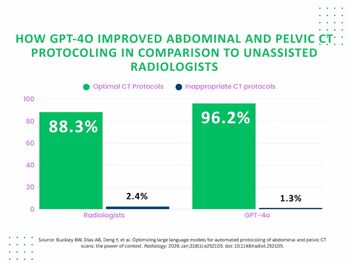
Whole-body PET/CT proves superior for staging cancers
Nuclear medicine physicians have suspected since the advent of PET/CT that the hybrid technology would outperform either PET or CT alone for staging cancer. Those suspicions have been confirmed in a study of 260 patients at the University of Essen, Germany. It found that PET/CT is substantially more accurate for staging carcinoma than PET or CT alone and even PET and CT viewed side by side (PET+CT).
Nuclear medicine physicians have suspected since the advent of PET/CT that the hybrid technology would outperform either PET or CT alone for staging cancer. Those suspicions have been confirmed in a study of 260 patients at the University of Essen, Germany. It found that PET/CT is substantially more accurate for staging carcinoma than PET or CT alone and even PET and CT viewed side by side (PET+CT).
The trial pitting one modality against the others indicated that PET/CT can be recommended as a first-line diagnostic tool for various cancers, said Dr. Patrick Veit, a research fellow who presented the study on behalf of principal investigator Dr. Gerald Antoch, an at-tending physician in the radiology department. Results were reported at the 2005 European Congress of Radiology in March.
The study involved 112 patients with primary tumors and 148 with suspected recurrent disease. Cases of lung, head and neck, gastrointestinal tract, liver, thyroid, and uterine cancers were included. The distribution of patients for T-stage, N-stage, and M-stage histology was 77, 72, and 57, respectively.
PET/CT correctly staged 63 of the T-stage patients, significantly more than the 55 who were correctly staged with PET+CT and with CT or PET alone. Of the N-stage patients, PET/CT staged 240, again significantly more than PET+CT and CT or PET alone. PET/CT was correct for 248 M-stage patients and was significantly more adept than PET and CT viewed separately, but it was no better than PET+CT in these cases.
Overall TNM-stage results indicated that 218 patients were correctly staged with PET/CT, significantly better than PET+CT, PET, and CT. P values quantifying the magnitude of statistical significance for all three sets of comparisons were in the 0.0001 range.
PET/CT would have altered patient management regardless of which approach was used for initial staging, based on German clinical guidelines for prescribing therapy, Veit said. It would hypothetically have changed the therapeutic recommendation in 17% of the cases if it had been used as a follow-up procedure after PET-based staging. Different therapies would have been prescribed for 17% of cases initially examined with CT and 6% of patients evaluated with PET+CT.
Two nuclear medicine specialists interpreted the PET images visually and then quantitatively based on standard uptake values. Two radiologists examined the CT scans. A radiologist and nuclear medicine specialist simultaneously performed side-by-side PET and CT analysis, as well as PET/CT image evaluation.
Newsletter
Stay at the forefront of radiology with the Diagnostic Imaging newsletter, delivering the latest news, clinical insights, and imaging advancements for today’s radiologists.




























